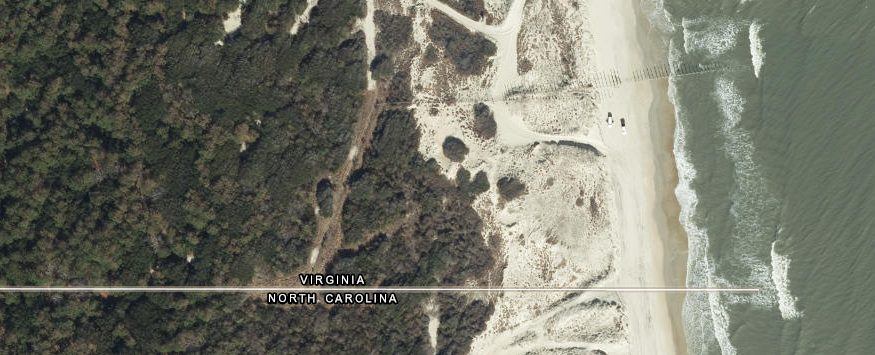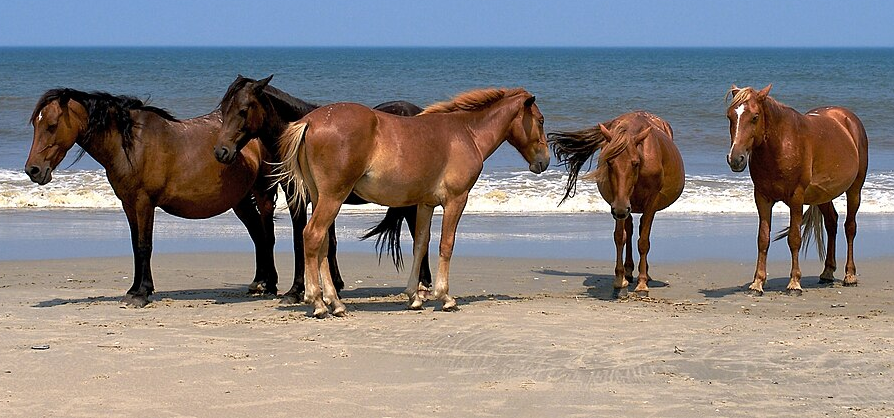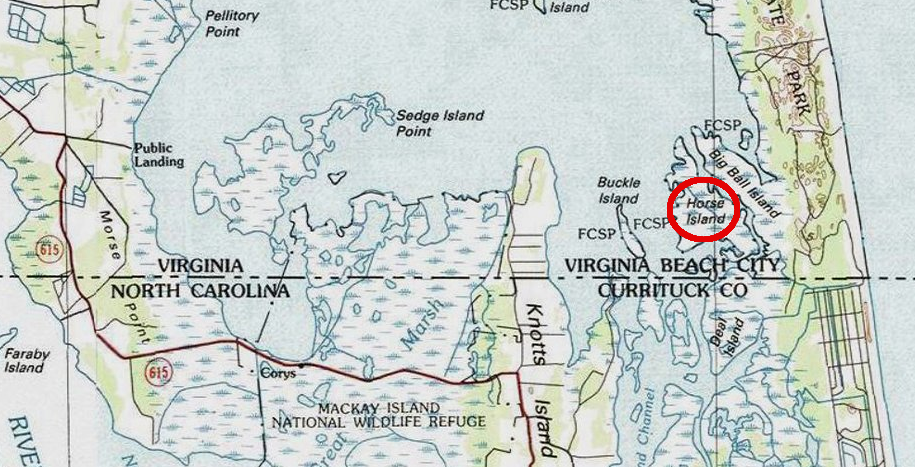
a fence, just north of the Virginia-North Carolina border, is intended to keep wild horses out of False Cape State Park
Source: ESRI, ArcGIS Online

a fence, just north of the Virginia-North Carolina border, is intended to keep wild horses out of False Cape State Park
Source: ESRI, ArcGIS Online
There is a herd of wild horses at the Virginia-North Carolina border, between False Cape State Park and Corolla. The herd is a remnant of the 5,000-6,000 Spanish mustangs that once roamed the Outer Banks. Jockeys Ridge, a popular destination near where the Wright brothers managed the first powered flight in 1903, is thought to be named for the local practice of racing wild horses there.
Currituck County in North Carolina advertises the "banker horses" as a tourist attraction and has defined a Wild Horse Sanctuary area. The horses are protected in that zone from disturbance, other than the presence of vehicles on the beach filled with tourists. It is against the law to try to ride the wild horses.
Some Federal lands, part of Currituck National Wildlife Refuge, are included within the Wild Horse Sanctuary zone. On the beach in northeastern North Carolina, the US Fish and Wildlife Service would prefer to eliminate the Corolla herd. That Federal agency prioritizes native species, so the horses introduced to the area by the Spanish are not welcome:1
In contrast, at Assateague National Seashore and at Chincoteague National Wildlife Refuge, the National Park Service and US Fish and Wildlife Service are willing to manage wild horses as part of the landscape.
A fence at the Virginia-North Carolina state line is intended to keep the wild horses out of False Cape State Park and Back Bay National Wildlife Refuge in Virginia Beach. The fence stretches from the shoreline of the Atlantic Ocean westward into the marsh on Deal Island. The fence stops in the wetlands, and does not extend completely through the marsh.
In 2018, a band of six horses led by a young stallion known as "Lucky Duck" sought repeatedly to bypass the fence. The herd evidently planned to establish a new territory in Virginia, minimizing competition with other stallions in North Carolina.
The Corolla Wild Horse Fund, which manages the 100 remaining horses in the herd, relocated the band several times back into North Carolina. After multiple migrations back into Virginia, the six horses were taken off the Outer Banks and permanently transferred to the Corolla Wild Horse Fund's rescue farm. About 20 horses live on the 30-acre farm, recovering from infection or isolated because they persistently try to move into beachfront developments.2
In 2006, a different herd led by a stallion named Red Feather crossed the border by swimming in the Atlantic Ocean around the fence. After four horses in the herd were hit by cars in Virginia Beach, the horses were rounded up and transported to a rescue farm in Pungo.3
DNA testing has revealed that the herd is descended from Spanish horses, with a few genes from domestic horses and even a donkey. The horses may have arrived originally in 1526 when Lucas Vasquez de Ayllon sought to establish a colony he called San Miguel de Guadelupe on the southeastern coastline. The Spanish stopped at the mouth of the Cape Fear River before settling at what may have been Winyah Bay near the South Santee River.

the "banker horses" south of the Virginia-North Carolina border are descended from Spanish horses brought to the New World in the 1500's
Source: Kevincollins123, Corolla, North Carolina
Allyon brought 600 people and 90 horses to the colony. Allyon died there, and after three months the colonists returned to Hispaniola. The horses stayed behind. Native Americans may have hunted them for food, but evidently some survived and managed to spread across the Outer Banks islands. Alternatively, the horses may have been purchased by Richard Grenville in 1585 when he visited Puerto Rico on the way to start the English colony at Roanoke Island.4

place names reveal the long heritage of wild horses near the Virginia-North Carolina border
Source: ESRI, ArcGIS Online